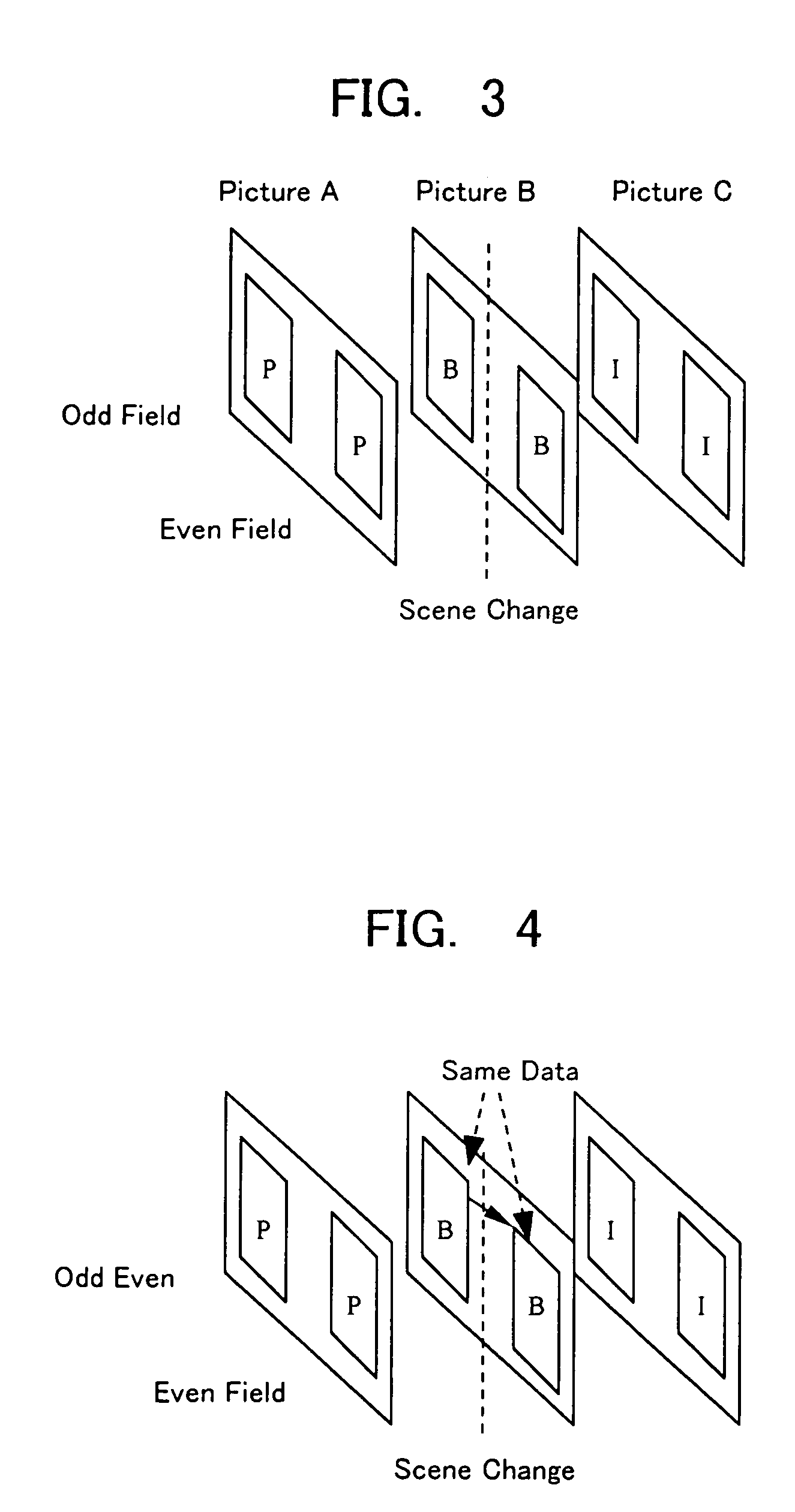Moving pictures encoding method and apparatus for detecting a scene change between fields of an interlaced image
a technology of interlaced images and encoding methods, applied in the field of moving pictures encoding methods, can solve the problems of increasing the amount of coded data, unable to say good efficiency, and the amount of information comprising the moving picture itself, and achieve good picture quality encoding
- Summary
- Abstract
- Description
- Claims
- Application Information
AI Technical Summary
Benefits of technology
Problems solved by technology
Method used
Image
Examples
first embodiment
[0124]FIG. 9 is a block diagram of an example of a constitution of a motion prediction decision device 6, which, as the present invention, realizes the above-mentioned first solution principle of the present invention. The present invention is characterized by the fact that it provides yet another prediction comparator 64 relative to the constitution of the motion prediction decision device 6 of FIG. 8.
[0125]Frame structure encoding realized by the embodiment shown in FIG. 9, as the first solution principle of the present invention illustrated in FIG. 1, adds a predictive mode, which, in B-picture field prediction, performs prediction from the forward direction for one field, and prediction from the backward direction for the other field.
[0126]To add this predictive mode, there is a possibility that an additional bit will be required in a macro-block unit from the standpoint of the syntax (data string convention). Therefore, this predictive mode is advantageous in that the constitut...
second embodiment
[0132]FIG. 10 is a block diagram of an example of a constitution of a motion prediction decision device 6 according to yet the present invention. The constitution is such that the output of prediction comparator 64, which is added relative to the embodiment of FIG. 9, is constantly inputted to prediction comparator 63.
[0133]Therefore, the constitution is such that, for a B-picture, prediction, which is always from a forward field prediction result for one field, and from a backward field prediction result for the other field, is entered into an item.
[0134]As described above, according to the present invention, a prediction mode, wherein there is 1 motion vector per direction in field prediction, is added as a new prediction mode.
[0135]Table 4 is a code table for an MPEG-2 frame structure prediction mode (Table 6-17 Meaning of frame#motion#type: ISO / IEC 13818-2 (MPEG-2-Video) definition of frame#motion#type).
[0136]
TABLE 4SpatialTemporalMotionWeightPredictionvectorMvCodeClassTypeCount...
third embodiment
[0146]FIG. 12 is a diagram illustrating the present invention. The constitution of FIG. 12 is such that, relative to the constitution of FIG. 9, the switching of the switch SW is controlled by a field scene change detecting circuit 65.
[0147]Now, in relation to the above description of the second embodiment, the ‘00’ of the code column in the above Table 3 becomes a ‘reserved’ bit in order to make the MPEG start code, which commonly holds a 0 in bit 23 and a 1 in bit 1, a unique word.
[0148]Therefore, when it is impossible to allocate a new motion prediction type to ‘00’, either the bits of a frame#motion#type must be increased 1 bit, or a new, at the minimum 1-bit mode identification bit must be provided.
[0149]In this case, since motion prediction is performed in macro-block units, for example, even if an additional bit is 1 bit, when conversion is carried out per picture, it constitutes a huge increase in bit quantity. Furthermore, it is very possible that efficiency is raised in ac...
PUM
 Login to View More
Login to View More Abstract
Description
Claims
Application Information
 Login to View More
Login to View More - R&D
- Intellectual Property
- Life Sciences
- Materials
- Tech Scout
- Unparalleled Data Quality
- Higher Quality Content
- 60% Fewer Hallucinations
Browse by: Latest US Patents, China's latest patents, Technical Efficacy Thesaurus, Application Domain, Technology Topic, Popular Technical Reports.
© 2025 PatSnap. All rights reserved.Legal|Privacy policy|Modern Slavery Act Transparency Statement|Sitemap|About US| Contact US: help@patsnap.com



